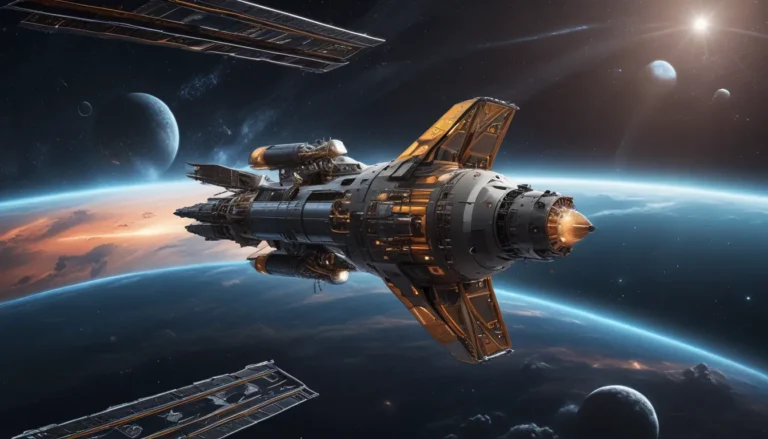The pictures we use in our articles might not show exactly what the words say. We choose these pictures to make you interested in reading more. The pictures work together with the words but don’t take their place. The words still tell you the important facts.
Space exploration has always been a subject of intrigue and wonder, captivating the human imagination and pushing the boundaries of our understanding of the universe. While astronauts and their daring missions often steal the spotlight, there is a hidden world of intricate infrastructure that plays a crucial role in enabling us to reach for the stars. In this article, we will delve into 13 intriguing facts about space launch infrastructure that highlight the incredible engineering and technological feats involved in sending rockets into space. From historical milestones to mind-boggling statistics, these facts shed light on the fascinating world behind the scenes of space launches.
Key Takeaways:
- Space launch infrastructure has a rich history, from the first launch in 1957 to the development of the largest rocket, the Saturn V, showcasing human achievement and collaboration.
- The future of space launch infrastructure is exciting, with reusable rockets like SpaceX’s Falcon 9 leading the way, making space exploration more affordable and accessible for everyone.
The Legacy of Space Launch Infrastructure
The journey of space exploration began on October 4, 1957, with the launch of the Soviet satellite Sputnik. This historic event marked the first human-made object to orbit the Earth and set the stage for future space missions. Since then, space launch infrastructure has evolved significantly, with monumental achievements like the development of the largest rocket ever built, the Saturn V. Standing at a staggering height of 363 feet, the Saturn V rocket remains a symbol of human ingenuity and determination, delivering astronauts to the moon during the Apollo program.
The Heart of Space Launch Operations
SpaceX, the pioneering aerospace company founded by Elon Musk, utilizes Space Launch Complex 40 at Cape Canaveral Space Force Station for its Falcon 9 rocket launches. This state-of-the-art facility has been instrumental in advancing space exploration, demonstrating the innovative approaches taken in modern space launch infrastructure. Additionally, Kennedy Space Center in Florida stands as the largest spaceport in the United States and a hub for NASA’s human spaceflight missions, hosting historic launches like the Apollo moon landings.
Historic and Iconic Spaceports
Baikonur Cosmodrome in Kazakhstan holds the title of being the oldest and largest spaceport still in operation, with a rich history of launching historic space missions, including the first human journey into space by Yuri Gagarin. On the other side of the world, the Vandenberg Space Force Base in California is renowned for its role in polar launches, offering strategic advantages for specific types of space missions that require polar or near-polar trajectories.
Collaboration in the Cosmos
The International Space Station (ISS) stands as a marvel of collaboration, involving multiple space agencies such as NASA, Roscosmos, ESA, JAXA, and CSA. This multinational project serves as an orbiting laboratory for scientific research, embodying the spirit of international cooperation in space exploration. The intricate systems on the ISS highlight the importance of robust space launch infrastructure in supporting long-duration missions in space.
Engineering Marvels and Innovations
During the launch process, space launch vehicles endure extreme vibrations due to the powerful engines and forces involved. Engineers employ advanced techniques like structure dampening and vibration isolation to mitigate these effects and ensure the structural integrity of the spacecraft. The iconic wall of fire seen during rocket launches is actually produced by the sound suppression system, which releases water to protect the launch infrastructure from heat and acoustic energy.
Safeguarding Spacecraft and Payloads
Spaceports are equipped with extensive safety measures to ensure successful and secure space missions. Rigorous safety protocols, emergency evacuation plans, and stringent inspection procedures are in place to protect the launch infrastructure and personnel involved in space launches. Payload fairings play a crucial role in shielding satellites and payloads from aerodynamic forces, temperature fluctuations, and debris encountered during the ascent, ensuring the safe deployment of spacecraft into orbit.
Precision in Spacecraft Assembly
The assembly of spacecraft takes place in state-of-the-art cleanrooms, where strict cleanliness standards are maintained to prevent contamination and protect sensitive space hardware. These highly controlled environments shield the spacecraft from particles and pollutants that could compromise their functionality, highlighting the meticulous attention to detail required in the assembly process.
Unlocking the Future of Space Exploration
The development of reusable rockets like SpaceX’s Falcon 9 and Falcon Heavy is revolutionizing space launch infrastructure, making space exploration more cost-effective and efficient. These advancements are opening up new possibilities for commercial space exploration and colonization, paving the way for ambitious missions to celestial bodies within our solar system and beyond. The future of space launch infrastructure promises continued innovation and progress, with ongoing advancements shaping the landscape of space exploration for generations to come.
In Conclusion
Space launch infrastructure stands as the backbone of our exploration and study of the vast Universe, enabling us to push the boundaries of human discovery and understanding. From the historical milestones of the past to the cutting-edge innovations of the present, each aspect of space launch infrastructure plays a vital role in supporting our endeavors in space exploration. As we look towards the future, the exciting developments in reusable rockets and advanced technologies signal a new era of space exploration, where the possibilities are limitless. The ongoing evolution of space launch infrastructure will continue to shape our understanding of the cosmos, bringing us closer to unlocking the mysteries of the Universe.
FAQs
Q: How important is space launch infrastructure?
A: Space launch infrastructure is crucial for the success of space missions, providing the necessary facilities for rocket assembly, launch, and tracking.
Q: What advancements are being made in space launch infrastructure?
A: Advancements like reusable rockets and advanced safety measures are revolutionizing space launch infrastructure, making space exploration more efficient and accessible.
Q: How does space launch infrastructure support space exploration?
A: Space launch infrastructure enables the assembly, launch, and tracking of spacecraft, supporting missions to explore the Universe and conduct scientific research.
Q: Are there plans for future space launch infrastructure developments?
A: Yes, ongoing developments in space launch infrastructure include new launch facilities, advancements in technology, and the expansion of commercial space exploration opportunities.






